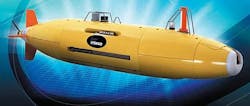Navy asks Metron for autonomy and control software for future large-displacement UUV
SAN DIEGO, 22 May 2013. U.S. Navy researchers needed experimental autonomy and mission planning software for a future large unmanned underwater vehicle (UUV) under development by the U.S. Office of Naval Research (ONR) in Arlington, Va. They found their solution from Metron Inc. in Reston, Va.
Officials of the Space and Naval Warfare (SPAWAR) Systems Center Pacific in San Diego, on behalf of ONR, awarded a $7.3 million contract to Metron on Monday for in-lab integration and testing of autonomy and mission planning software with bench test hardware selected for deployment on the future Large Displacement Unmanned Undersea Vehicle (LDUUV). Autonomy for the LDUUV involves autonomy software, computer hardware, and sensors.
ONR's LDUUV project seeks to develop a large unmanned submarine able to operate in the open ocean and in coastal waters and harbors on missions lasting more than 70 days to gather intelligence, surveillance, and reconnaissance (ISR) information. The program is developing UUV autonomy and long-endurance propulsion systems for large UUVs.
The LDUUV is to be a pier-launched and recovered large unmanned submersible able to operate in the open ocean and conduct over-the-horizon sensor missions in coastal waters and harbors.
The future LDUUV must be able to avoid all vessels in its area of operations, including fishing boats. Development challenges include detecting and avoiding undersea stationary and moving obstacles, as well as path planning algorithms to minimize energy consumption while avoiding obstacles; detecting, locating, and identifying surface vessels; determining the intent of detected surface vessels; and detecting and avoiding all kinds of fishing nets and fishing gear, including mono-filament and twine nets which are difficult to detect. Once outside the specified areas, human operators may intervene over satellite links, if necessary.
In addition to Metron, other companies are working on autonomy and control for the future LDUUV. UUV designer Hydroid Inc. in Pocasset, Mass., also is developing an autonomy testing system for the LDUUV. Hydroid is a subsidiary of Kongsberg Maritime AS in Kongsberg, Norway.
Hydroid uses the Remote Environmental Measuring Units (REMUS) UUV as an autonomy testing system for LDUUV technology. The vehicle-control architecture is the same in the LDUUV and REMUS autonomous underwater vehicles, making it easy to move software from one vehicle to the other.
On the LDUUV program, several companies also are developing propulsion and power technologies for the future large unmanned submersible. Among the companies working on LDUUV power and propulsion technologies are Fuelcell Energy Inc. in Danbury, Conn.; Sierra Lobo Inc. in Fremont, Ohio; the Hamilton Sundstrand Corp. Sea Systems segment, in Windsor Locks, Conn.; General Atomics in San Diego; Lynntech Inc. in College Station, Texas; and NexTech Materials Ltd. in Lewis Center, Ohio.
Metron's one-year contract includes two, one-year options which, if exercised, would bring the potential cumulative value of the contract to $18.3 million.
On this contract Metron will do the work in Reston, Va., and Alameda, Calif., and should be finished by March 2014. If options are exercised work will continue through March 2016.
For more information contact Metron online at www.metsci.com, or SPAWAR Systems Center Pacific at www.public.navy.mil/SPAWAR/PACIFIC.

